Diego Paez-Granados
EPFL
Shared Control of Holonomic Wheelchairs through Reinforcement Learning
Jul 22, 2025Abstract:Smart electric wheelchairs can improve user experience by supporting the driver with shared control. State-of-the-art work showed the potential of shared control in improving safety in navigation for non-holonomic robots. However, for holonomic systems, current approaches often lead to unintuitive behavior for the user and fail to utilize the full potential of omnidirectional driving. Therefore, we propose a reinforcement learning-based method, which takes a 2D user input and outputs a 3D motion while ensuring user comfort and reducing cognitive load on the driver. Our approach is trained in Isaac Gym and tested in simulation in Gazebo. We compare different RL agent architectures and reward functions based on metrics considering cognitive load and user comfort. We show that our method ensures collision-free navigation while smartly orienting the wheelchair and showing better or competitive smoothness compared to a previous non-learning-based method. We further perform a sim-to-real transfer and demonstrate, to the best of our knowledge, the first real-world implementation of RL-based shared control for an omnidirectional mobility platform.
Sim-to-Real Transfer for Mobile Robots with Reinforcement Learning: from NVIDIA Isaac Sim to Gazebo and Real ROS 2 Robots
Jan 06, 2025



Abstract:Unprecedented agility and dexterous manipulation have been demonstrated with controllers based on deep reinforcement learning (RL), with a significant impact on legged and humanoid robots. Modern tooling and simulation platforms, such as NVIDIA Isaac Sim, have been enabling such advances. This article focuses on demonstrating the applications of Isaac in local planning and obstacle avoidance as one of the most fundamental ways in which a mobile robot interacts with its environments. Although there is extensive research on proprioception-based RL policies, the article highlights less standardized and reproducible approaches to exteroception. At the same time, the article aims to provide a base framework for end-to-end local navigation policies and how a custom robot can be trained in such simulation environment. We benchmark end-to-end policies with the state-of-the-art Nav2, navigation stack in Robot Operating System (ROS). We also cover the sim-to-real transfer process by demonstrating zero-shot transferability of policies trained in the Isaac simulator to real-world robots. This is further evidenced by the tests with different simulated robots, which show the generalization of the learned policy. Finally, the benchmarks demonstrate comparable performance to Nav2, opening the door to quick deployment of state-of-the-art end-to-end local planners for custom robot platforms, but importantly furthering the possibilities by expanding the state and action spaces or task definitions for more complex missions. Overall, with this article we introduce the most important steps, and aspects to consider, in deploying RL policies for local path planning and obstacle avoidance with Isaac Sim training, Gazebo testing, and ROS 2 for real-time inference in real robots. The code is available at https://github.com/sahars93/RL-Navigation.
Torso-Based Control Interface for Standing Mobility-Assistive Devices
Dec 04, 2023Abstract:Wheelchairs and mobility devices have transformed our bodies into cybernic systems, extending our well-being by enabling individuals with reduced mobility to regain freedom. Notwithstanding, current interfaces of control require to use the hands, therefore constraining the user from performing functional activities of daily living. In this work, we present a unique design of torso-based control interface with compliant coupling support for standing mobility assistive devices. We take the coupling between the human and robot into consideration in the interface design. The design includes a compliant support mechanism and a mapping between the body movement space and the velocity space. We present experiments including multiple conditions, with a joystick for comparison with the proposed torso control interface. The results of a path-following experiment showed that users were able to control the device naturally using the hands-free interface, and the performance was comparable with the joystick, with 10% more consumed time, an average cross error of 0.116 m and 4.9% less average acceleration. The result of an object-transferring experiment showed the advantage of using the proposed interface in case users needed to manipulate objects while locomotion. The torso control scored 15% less in the System Usability Scale than the joystick in the path following task but 3.3% more in the object transferring task.
Pedestrian-Robot Interactions on Autonomous Crowd Navigation: Reactive Control Methods and Evaluation Metrics
Aug 03, 2022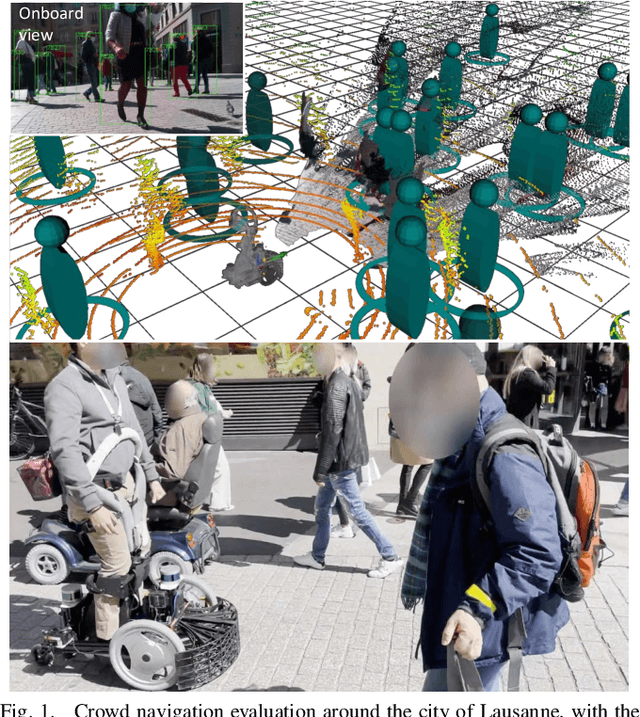
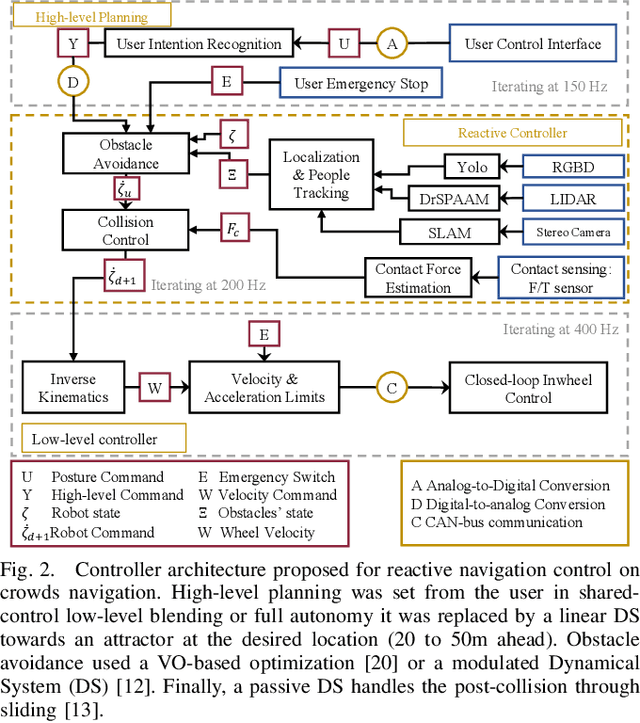
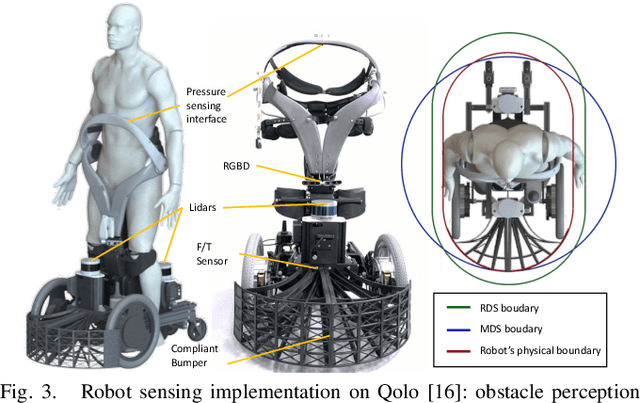
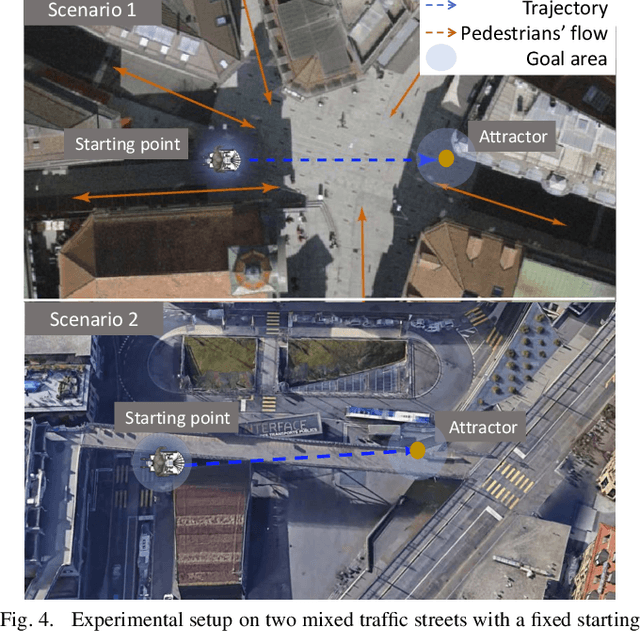
Abstract:Autonomous navigation in highly populated areas remains a challenging task for robots because of the difficulty in guaranteeing safe interactions with pedestrians in unstructured situations. In this work, we present a crowd navigation control framework that delivers continuous obstacle avoidance and post-contact control evaluated on an autonomous personal mobility vehicle. We propose evaluation metrics for accounting efficiency, controller response and crowd interactions in natural crowds. We report the results of over 110 trials in different crowd types: sparse, flows, and mixed traffic, with low- (< 0.15 ppsm), mid- (< 0.65 ppsm), and high- (< 1 ppsm) pedestrian densities. We present comparative results between two low-level obstacle avoidance methods and a baseline of shared control. Results show a 10% drop in relative time to goal on the highest density tests, and no other efficiency metric decrease. Moreover, autonomous navigation showed to be comparable to shared-control navigation with a lower relative jerk and significantly higher fluency in commands indicating high compatibility with the crowd. We conclude that the reactive controller fulfils a necessary task of fast and continuous adaptation to crowd navigation, and it should be coupled with high-level planners for environmental and situational awareness.
* \c{opyright}IEEE All rights reserved. IEEE-IROS-2022, Oct.23-27. Kyoto, Japan
Unfreezing Social Navigation: Dynamical Systems based Compliance for Contact Control in Robot Navigation
Mar 02, 2022



Abstract:Large efforts have focused on ensuring that the controllers for mobile service robots follow proxemics and other social rules to ensure both safe and socially acceptable distance to pedestrians. Nonetheless, involuntary contact may be unavoidable when the robot travels in crowded areas or when encountering adversarial pedestrians. Freezing the robot in response to contact might be detrimental to bystanders' safety and prevents it from achieving its task. Unavoidable contacts must hence be controlled to ensure the safe and smooth travelling of robots in pedestrian alleys. We present a force-limited and obstacle avoidance controller integrated into a time-invariant dynamical system (DS) in a closed-loop force controller that let the robot react instantaneously to contact or to the sudden appearance of pedestrians. Mitigating the risk of collision is done by modulating the velocity commands upon detecting a contact and by absorbing part of the contact force through active compliant control when the robot bumps inadvertently against a pedestrian. We evaluated our method with a personal mobility robot -- Qolo -- showing contact mitigation with passive and active compliance. We showed the robot able to overcome an adversarial pedestrian within 9 N of the set limit contact force for speeds under 1 m/s. Moreover, we evaluated integrated obstacle avoidance proving the ability to advance without incurring any other collision.
* 7 pages
Personal Mobility With Synchronous Trunk-Knee Passive Exoskeleton: Optimizing Human-Robot Energy Transfer
Jan 10, 2022



Abstract:We present a personal mobility device for lower-body impaired users through a light-weighted exoskeleton on wheels. On its core, a novel passive exoskeleton provides postural transition leveraging natural body postures with support to the trunk on sit-to-stand and stand-to-sit (STS) transitions by a single gas spring as an energy storage unit. We propose a direction-dependent coupling of knees and hip joints through a double-pulley wire system, transferring energy from the torso motion towards balancing the moment load at the knee joint actuator. Herewith, the exoskeleton maximizes energy transfer and the naturalness of the user's movement. We introduce an embodied user interface for hands-free navigation through a torso pressure sensing with minimal trunk rotations, resulting on average $19^{\circ} \pm 13^{\circ}$ on six unimpaired users. We evaluated the design for STS assistance on 11 unimpaired users observing motions and muscle activity during the transitions. Results comparing assisted and unassisted STS transitions validated a significant reduction (up to $68\%$ $p<0.01$) at the involved muscle groups. Moreover, we showed it feasible through natural torso leaning movements of $+12^{\circ}\pm 6.5^{\circ}$ and $- 13.7^{\circ} \pm 6.1^{\circ}$ for standing and sitting, respectively. Passive postural transition assistance warrants further work on increasing its applicability and broadening the user population.
Virtual Landmark-Based Control of Docking Support for Assistive Mobility Devices
Jul 28, 2021


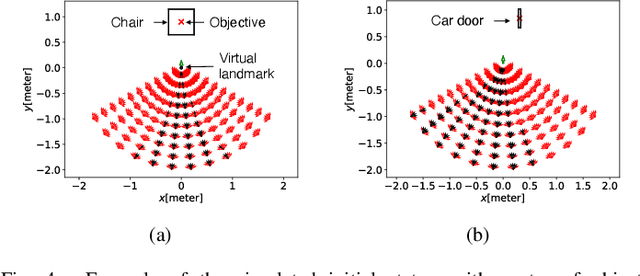
Abstract:This work proposes an autonomous docking control for nonholonomic constrained mobile robots and applies it to an intelligent mobility device or wheelchair for assisting the user in approaching resting furniture such as a chair or a bed. We defined a virtual landmark inferred from the target docking destination. Then, we solve the problem of keeping the targeted volume inside the field of view (FOV) of a tracking camera and docking to the virtual landmark through a novel definition that enables to control for the desired end-pose. In this article, we proposed a nonlinear feedback controller to perform the docking with the depth camera's FOV as a constraint. Then, a numerical method is proposed to find the feasible space of initial states where convergence could be guaranteed. Finally, the entire system was embedded for real-time operation on a standing wheelchair with the virtual landmark estimation by 3D object tracking with an RGB-D camera and we validated the effectiveness in simulation and experimental evaluations. The results show the guaranteed convergence for the feasible space depending on the virtual landmark location. In the implementation, the robot converges to the virtual landmark while respecting the FOV constraints.
* IEEE/ASME International Conference on Advanced Intelligent Mechatronics (AIM2021), JULY 12-16. Virtual Conference hosted by TU Delft, Delft, The Netherlands. Presentation video: https://www.youtube.com/watch?v=p6DzbjV6w4c
Crowd against the machine: A simulation-based benchmark tool to evaluate and compare robot capabilities to navigate a human crowd
Apr 29, 2021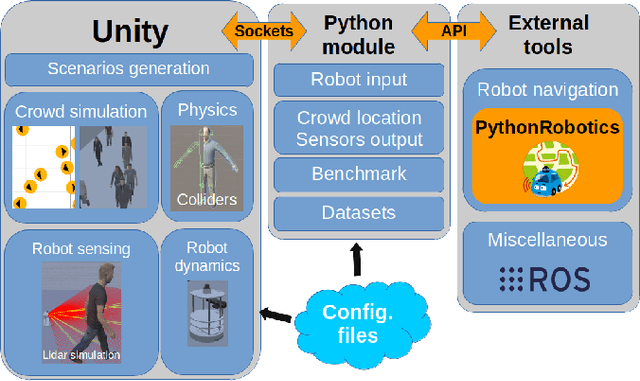
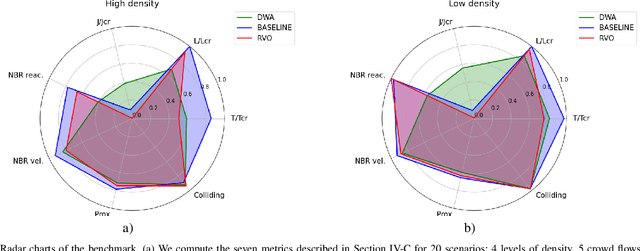
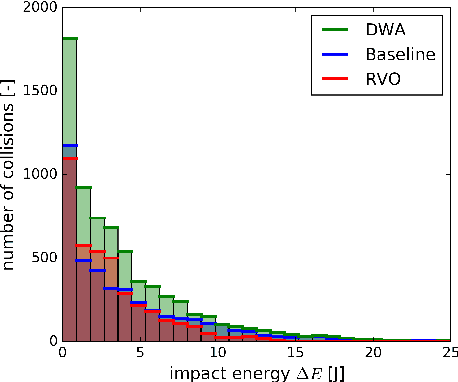

Abstract:The evaluation of robot capabilities to navigate human crowds is essential to conceive new robots intended to operate in public spaces. This paper initiates the development of a benchmark tool to evaluate such capabilities; our long term vision is to provide the community with a simulation tool that generates virtual crowded environment to test robots, to establish standard scenarios and metrics to evaluate navigation techniques in terms of safety and efficiency, and thus, to install new methods to benchmarking robots' crowd navigation capabilities. This paper presents the architecture of the simulation tools, introduces first scenarios and evaluation metrics, as well as early results to demonstrate that our solution is relevant to be used as a benchmark tool.
Passive Flow Control for Series Inflatable Actuators: Application on a Wearable Soft-Robot for Posture Assistance
Mar 09, 2021
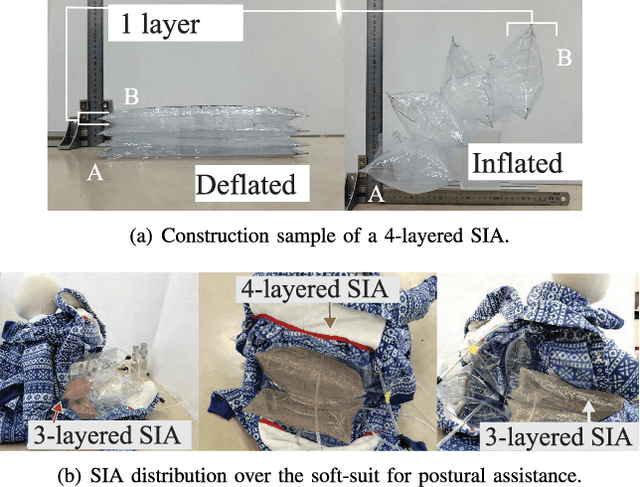
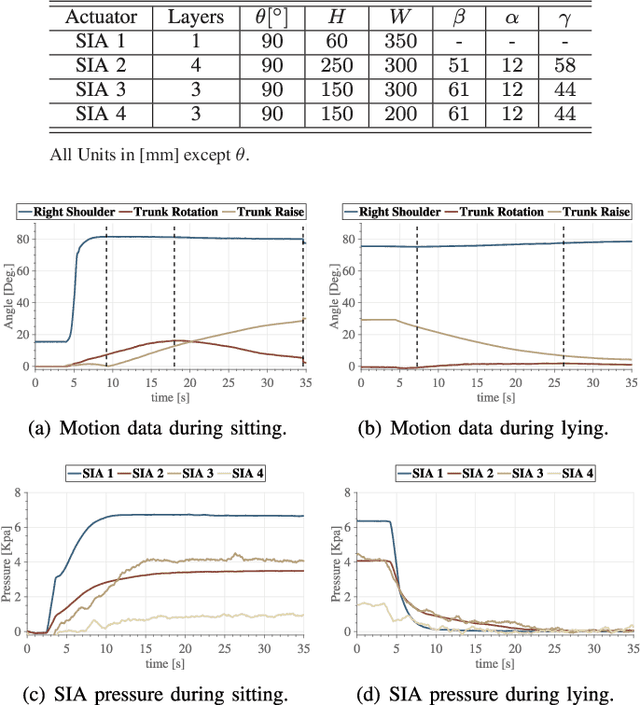

Abstract:This paper presents a passive control method for multiple degrees of freedom in a soft pneumatic robot through the combination of flow resistor tubes with series inflatable actuators. We designed and developed these 3D printed resistors based on the pressure drop principle of multiple capillary orifices, which allows a passive control of its sequential activation from a single source of pressure. Our design fits in standard tube connectors, making it easy to adopt it on any other type of actuator with pneumatic inlets. We present its characterization of pressure drop and evaluation of the activation sequence for series and parallel circuits of actuators. Moreover, we present an application for the assistance of postural transition from lying to sitting. We embedded it in a wearable garment robot-suit designed for infants with cerebral palsy. Then, we performed the test with a dummy baby for emulating the upper-body motion control. The results show a sequential motion control of the sitting and lying transitions validating the proposed system for flow control and its application on the robot-suit.
* Copyright IEEE All rights reserved.Personal use of this material is permitted. Permission from IEEE must be obtained for all other uses. IEEE-RAL-RoboSoft-2021, April 12-16. Virtual Conference hosted by Yale, USA
Control Interface for Hands-free Navigation of Standing Mobility Vehicles based on Upper-Body Natural Movements
Aug 03, 2020



Abstract:In this paper, we propose and evaluate a novel human-machine interface (HMI) for controlling a standing mobility vehicle or person carrier robot, aiming for a hands-free control through upper-body natural postures derived from gaze tracking while walking. We target users with lower-body impairment with remaining upper-body motion capabilities. The developed HMI bases on a sensing array for capturing body postures; an intent recognition algorithm for continuous mapping of body motions to robot control space; and a personalizing system for multiple body sizes and shapes. We performed two user studies: first, an analysis of the required body muscles involved in navigating with the proposed control; and second, an assessment of the HMI compared with a standard joystick through quantitative and qualitative metrics in a narrow circuit task. We concluded that the main user control contribution comes from Rectus Abdominis and Erector Spinae muscle groups at different levels. Finally, the comparative study showed that a joystick still outperforms the proposed HMI in usability perceptions and controllability metrics, however, the smoothness of user control was similar in jerk and fluency. Moreover, users' perceptions showed that hands-free control made it more anthropomorphic, animated, and even safer.
* 2020 IEEE. Personal use of this material is permitted. Permission from IEEE must be obtained for all other uses
 Add to Chrome
Add to Chrome Add to Firefox
Add to Firefox Add to Edge
Add to Edge